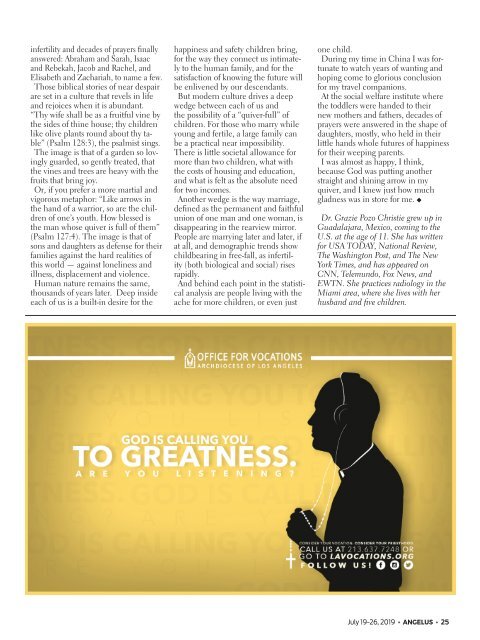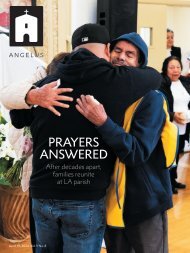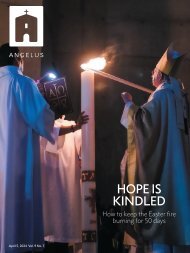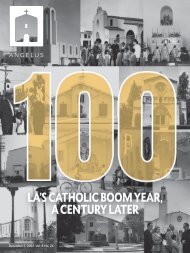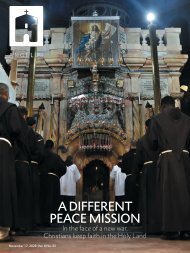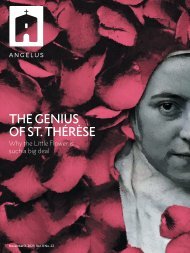Angelus News | July 19-26, 2019 | Vol. 4 No. 26
A 12th-century Byzantine mosaic depicts the Gospel story of Jairus asking Jesus to heal his dying 12-year-old daughter. For two millennia, the Catholic Church has been in the business of treating spiritual ailments — but that doesn’t mean it’s ignored people’s physical ailments. In fact, the world has Christianity and its founder to thank for some of the foundational principles of modern medicine. On Page 10, contributing editor Mike Aquilina tells the story of how the countercultural beliefs of early Christians led to one of society’s greatest inventions, the hospital. On Page 14, Angelus’ R.W. Dellinger tells the story of how a home hospice nurse is living out Jesus’ healing imperative by accompanying patients in their final moments.
A 12th-century Byzantine mosaic depicts the Gospel story of Jairus asking Jesus to heal his dying 12-year-old daughter. For two millennia, the Catholic Church has been in the business of treating spiritual ailments — but that doesn’t mean it’s ignored people’s physical ailments. In fact, the world has Christianity and its founder to thank for some of the foundational principles of modern medicine. On Page 10, contributing editor Mike Aquilina tells the story of how the countercultural beliefs of early Christians led to one of society’s greatest inventions, the hospital. On Page 14, Angelus’ R.W. Dellinger tells the story of how a home hospice nurse is living out Jesus’ healing imperative by accompanying patients in their final moments.
You also want an ePaper? Increase the reach of your titles
YUMPU automatically turns print PDFs into web optimized ePapers that Google loves.
infertility and decades of prayers finally<br />
answered: Abraham and Sarah, Isaac<br />
and Rebekah, Jacob and Rachel, and<br />
Elisabeth and Zachariah, to name a few.<br />
Those biblical stories of near despair<br />
are set in a culture that revels in life<br />
and rejoices when it is abundant.<br />
“Thy wife shall be as a fruitful vine by<br />
the sides of thine house; thy children<br />
like olive plants round about thy table”<br />
(Psalm 128:3), the psalmist sings.<br />
The image is that of a garden so lovingly<br />
guarded, so gently treated, that<br />
the vines and trees are heavy with the<br />
fruits that bring joy.<br />
Or, if you prefer a more martial and<br />
vigorous metaphor: “Like arrows in<br />
the hand of a warrior, so are the children<br />
of one’s youth. How blessed is<br />
the man whose quiver is full of them”<br />
(Psalm 127:4). The image is that of<br />
sons and daughters as defense for their<br />
families against the hard realities of<br />
this world — against loneliness and<br />
illness, displacement and violence.<br />
Human nature remains the same,<br />
thousands of years later. Deep inside<br />
each of us is a built-in desire for the<br />
happiness and safety children bring,<br />
for the way they connect us intimately<br />
to the human family, and for the<br />
satisfaction of knowing the future will<br />
be enlivened by our descendants.<br />
But modern culture drives a deep<br />
wedge between each of us and<br />
the possibility of a “quiver-full” of<br />
children. For those who marry while<br />
young and fertile, a large family can<br />
be a practical near impossibility.<br />
There is little societal allowance for<br />
more than two children, what with<br />
the costs of housing and education,<br />
and what is felt as the absolute need<br />
for two incomes.<br />
Another wedge is the way marriage,<br />
defined as the permanent and faithful<br />
union of one man and one woman, is<br />
disappearing in the rearview mirror.<br />
People are marrying later and later, if<br />
at all, and demographic trends show<br />
childbearing in free-fall, as infertility<br />
(both biological and social) rises<br />
rapidly.<br />
And behind each point in the statistical<br />
analysis are people living with the<br />
ache for more children, or even just<br />
one child.<br />
During my time in China I was fortunate<br />
to watch years of wanting and<br />
hoping come to glorious conclusion<br />
for my travel companions.<br />
At the social welfare institute where<br />
the toddlers were handed to their<br />
new mothers and fathers, decades of<br />
prayers were answered in the shape of<br />
daughters, mostly, who held in their<br />
little hands whole futures of happiness<br />
for their weeping parents.<br />
I was almost as happy, I think,<br />
because God was putting another<br />
straight and shining arrow in my<br />
quiver, and I knew just how much<br />
gladness was in store for me. <br />
Dr. Grazie Pozo Christie grew up in<br />
Guadalajara, Mexico, coming to the<br />
U.S. at the age of 11. She has written<br />
for USA TODAY, National Review,<br />
The Washington Post, and The New<br />
York Times, and has appeared on<br />
CNN, Telemundo, Fox <strong>News</strong>, and<br />
EWTN. She practices radiology in the<br />
Miami area, where she lives with her<br />
husband and five children.<br />
<strong>July</strong> <strong>19</strong>-<strong>26</strong>, 20<strong>19</strong> • ANGELUS • 25


